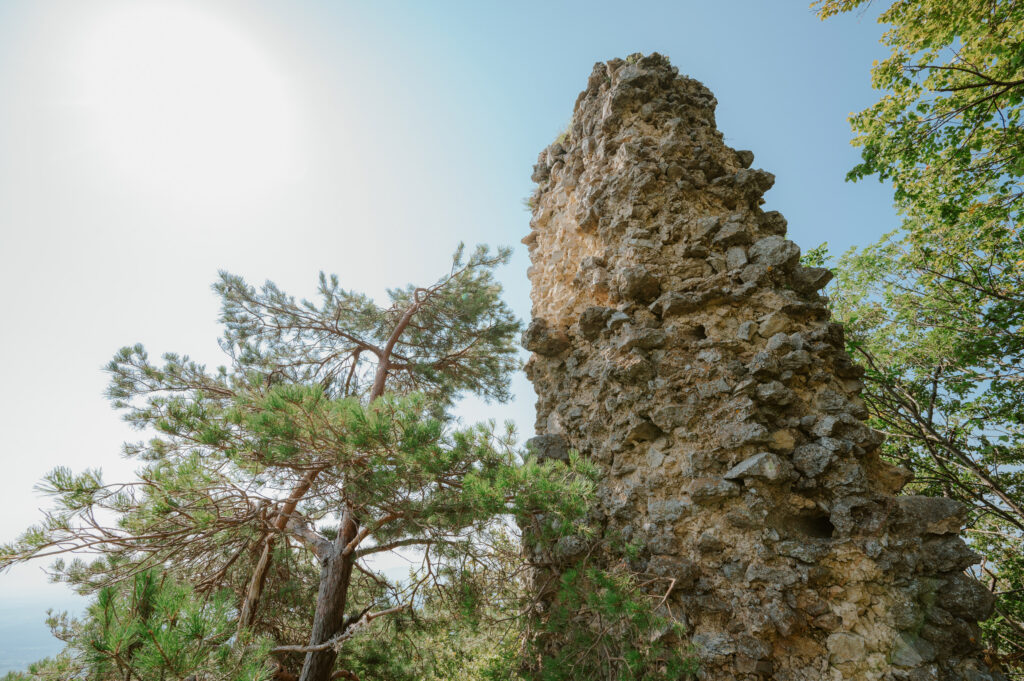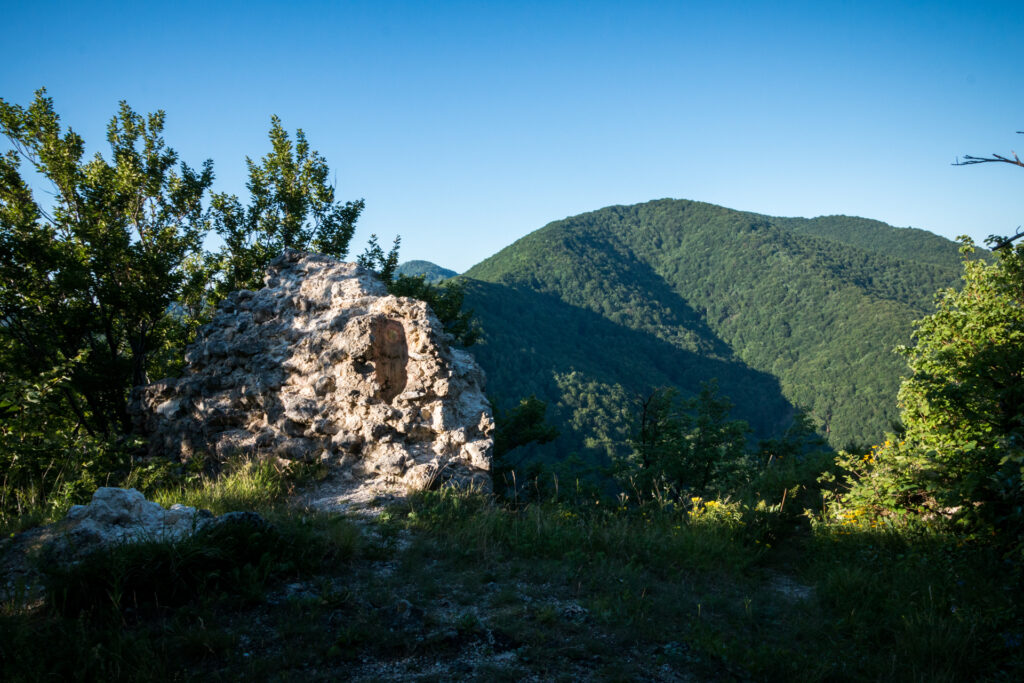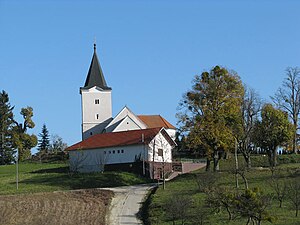History of burg
When exactly the building was built is unknown. But given its location, it certainly arose after the Mongol invasion because romanesque burgs (from the period before the Mongol invasion) are located at lower altitudes while gothic (built after the Mongols) out of fear are located, as they would say, the more the better. In his work “Castle and society in medieval Hungary (1000-1437)”, E. Fügedi argues that Oštrc, together with Kostel, was built by the prefect Farkaš who in 1247. from the king he gets permission to erect a burg that he has already begun to build on his property. It is not clear whether this permit applies to Kostel or perhaps ostrac.
In historical documents Oštrc is mentioned as Oztruz, Oztruch, Ostercz, Oztrocha. E. Laszowski states that the name must have become from a hill that is sharp i.e. conical. Oštrc hill was first mentioned in 1258. as a landmark of the church of St. Peter. George in White. 1334. The church of St. John is mentioned in the proceedings of the Archdeacon of Gorizia. St. Martin’s Chapel (Chapel of St. Martin) Martin in Martinšćina). Mr. Szabo writes that Oštrc, as a castrum, was first mentioned in 1330. owned by Petar Güssing together with Krapina and Kostel.
In 1399, the owners of the estate became the princes of Celje (Herman II and his sons Ludovic and Frederick II) when King Sigismund of Luxembourg gave them the entire Zagorje County with burgs Krapina, Lobor, Oštrac, Belac, Trakošćan, Lepoglava, Kostel and Cesargrad and the village of Trnovac. Oštrc remained in the ownership of the Celjes until their extinction in 1456. After the death of Ulrik II, the last celje, Oštrc was held by his widow Katarina Branković. This was the era of fighting between the new King Matthias Corvinus and the German Emperor Friedrich. At that time, the Emperor ordered his supreme captain Ivan Vitovac to take over all the fortresses of Celje in Croatia.
Soon Vitovac was mentioned as the owner of Oštrac, so there is a possibility that the widow Katarina sold him the property. Vitovac then adhered to King Matthias, who appointed him ban and in 1463. he issues a deed of donation by which he leaves zagorje county with all the fortifications. After Vitovec’s death, the estate was held by his sons, and when they reneged against King Matthias and joined emperor Maximilian (Friedrich’s son), Matthias declared them traitors and confiscated their possessions.
In 1494, four years after the death of King Matthias, his son Ivan Korvin became the owner of Oštrac. he donated to Nikola Mladinčić, originally from Dalmatia, for his merits, but it seems that he soon buys it back because Ivan again donates Oštrc as early as 1497, this time Marčinka of Supan-potok (i.e. from Predryhov) and his father Šimun Zdarišić.
There is not much information about the Marčinko family, it is not known how long they held Oštrc and what happened with the fort until the second half of the 16th century. St. Probably at some point the burg came back into the hands of Ivan Korvin and, after his death, into the property of the widow Beatrice Frankopan, who remarried Margrave Juraj of Brandenburg. Margrave of Brandenburg, a famous spendthrift, pawned Oštrc in 1513. Ljudevit Pekri Petrovinski, and the following year the Margrave concluded a contract with Duke Lawrence Illočki, by which he left zagorje burgs, including Oštrc.
However, Juraj Of Brandenburg would not be Juraj Brandenburgif he did not go contrary to his word and rebelled against the introduction of Duke Lawrence into possession, so Oštrc eventually remained in the hands of Ljudevit Pekri. His daughter Jelena marries Mirko Bradač Ladomirski, which puts part of the stranded estate in the hands of the Bradač family. Then, through marriage bonds, the kastelanfi family acquires the right to a part of the estate.
1568. King Maximilian donates Oštrc to Stjepan and Margareta Bradač and Nikola, Sofia and Ivan Berzaj as well as To Petar Kastelanfi. This was followed by years of feuds and ownership lawsuits between the Bojničić, Berzaj, Kastelanfi, Heršić, Kerečenji, Bradač families… as a result, the subject of discussion – burg Oštrc – was neglected and left to decay and in the middle of the 17th century. St. it is mentioned as a ruin (castrum dirutum).
Location and description of the burg
On one prominent “čuka” in the western part of Ivanščica lies burg Oštrc. Anyone who looks at it from the foot of the mountain will immediately understand how it got its name. The clichliest peak of Ivanščica is the one on which Oštrc stands. Burg is located on one peak of SZ Ivanščica, at a height of 736 m, making it the highest among the burgs of NW Croatia. The position in which it is located controls the entire Croatian Zagorje, and partly the regions towards Lepoglava.
The road that still leads from Lobor and Martinšćina to burg is the same as in the Middle Ages. The burg itself is the most accessible from the NW side where it goes and the access path that separates from the forest road (10 minutes of ascent). Approaching the burgu path from the northwest, we first come to a small, narrow entrance tower built of broken stone with stone masons at the corners. Two arrows have been preserved on it, and there is also the HPO stamp.
Passing through the tower, we enter the suburb: the burg, namely, consists of two parts – the main part at the highest point of the hill and the suburbs on the lower plateau. The suburb is surrounded by strong walls built similar to the entrance tower. To the right of the tower you can see traces of a room/building while further south wards provide poorly visible remains of walls.
At the highest point of the hill there is a narrow plateau with two towers and buildings for living. The northern round tower has been preserved only partially in the lower part. The outer mantle of the tower wall is made of carved stone broken, while the core is made of piled fractured with mortar. Given that circular towers in continental Croatia appeared only in the 15th century, we can safely say that this tower is not older than that time.
Between the northern and southern towers, the plateau was enclosed by an eastern defensive wall, built on the very edge of the cliff, today preserved only in traces. It was the most inaccessible and safest part of the burg, so against the wall were housing buildings (probably palaces) that stretched along the entire length of the plateau between the towers. And they are preserved only in the foundations. On the unbuilt part of the plateau there was probably an inner courtyard.
The south tower of a quadrangular shape is, next to the entrance tower, the best preserved part of the burg. It was built similarly to the northern one with a core of thrown stone broken and an outer mantle that has now completely fallen off except on the west side where part of the western wall still stands. The wall is preserved to a height of about 2 floors.
At the height of the first floor there is a well-preserved cannon opening on which, on the outside, there are two stone Gothic profilations (here as spolia – building material in secondary use).
Mr. Szabo believes that the quadrangular tower was later upgraded and that initially the only defender of the tower was the northern one. The quadrangular tower, according to it, neither in shape nor size fits with other building parts, and the southwestern defensive wall around the upper plateau continues further below the tower and merges with the eastern wall (visible under the ruins of the tower). On the east side of the tower, at the height of the ground floor, some extensions are noticed, and there is also a remodeling in the interior.
Because of all this, it is possible that in the same place stood the original tower defender around which the rest of the burg was located. That tower could later have either been replaced with a new one or just rebuilt (upgraded). At the beginning of the century, the tower was still relatively well preserved, but to this day it has unfortunately collapsed quite a bit. Just a small note – along with the Jew, Oštrc is the only burg on Ivanščica that has a real defender tower.






















